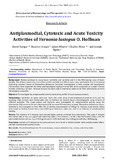Antiplasmodial, cytotoxic and acute toxicity activities of vernonia lasiopus o. Hoffman

View/
Date
2015Author
Njenga, David
Irungu, Beatrice
Mbaria, James
Mutai, Charles
Nguta, Joseph
Type
ArticleLanguage
enMetadata
Show full item recordAbstract
Background: Malaria continues to cause heavy morbidity and mortality and it is the fifth leading cause of death
globally. The disease causes over one million deaths annually and affects many more, particularly due to increasing
multi-drug resistant strains of Plasmodium falciparum. Sustained investigations in both curative and prophylactic
interventions have supported the ethno-pharmacological approach to identify novel compounds as a major channel
towards achieving a solution. Vernonia lasiopus has been used in traditional medicine for their antimalarial, antiviral
and analgesic properties.
Objective: To investigate the antiplasmodial activity and toxicity profile Vernonia lasiopus extracts.
Methodology: Extraction of aerial parts and roots was done using dichloromethane:chloroform (1:1) and the
resulting crude extracts each fractionated into six fractions by vacuum liquid chromatography using solvents of
different polarities. The crude extract and fractions were investigated for antiplasmodial activity using the
chloroquine (CQ) sensitive D6 and chloroquine (CQ) resistant W2 laboratory adapted Plasmodium falciparum strains.
Cytotoxicity was evaluated on Vero 199 cells at starting concentrations of 100μg/ml, whereas acute toxicity (LD50)
determined on healthy female Swiss mice (20±2 gm.). Selectivity index was used as an indicator of antiplasmodial
viability.
Results: The fractions of V. lasiopus roots showed higher activity combined than individually. The crude V. lasiopus
root extract had an IC50 13.1 μg/ml and selectivity index >7.63. Fraction 1 of the crude root extract (VLR1) was the
most viable fraction with an IC50 of 16.8 μg/ml and S.I >5.95. Both had CC50>100 μg/ml and LD50 >5000mg/kg.
Conclusion: extracts of V. lasiopus aerial parts and roots were found to exhibit notable viable antiplasmodial effects,
and had minimal acute toxicity in mice.
Citation
Njenga, D., Irungu, B., Mbaria, J., Mutai, C., & Nguta, J. (2015). Antiplasmodial, Cytotoxic and Acute Toxicity Activities of Vernonia lasiopus O. Hoffman. African Journal of Pharmacology and Therapeutics Vol, 4(1), 16-20.Publisher
University of Nairobi
Subject
Plasmodium falciparum, Vernonia lasiopus, antiplasmodial activity, toxicity, selectivity indexCollections
- Faculty of Health Sciences (FHS) [10415]
